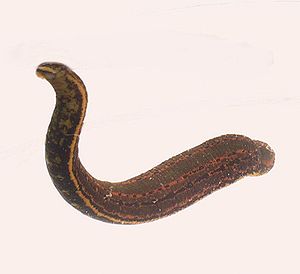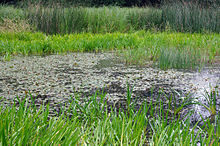Medical leech
| Medical leech | ||||||||||||
|---|---|---|---|---|---|---|---|---|---|---|---|---|

Medicinal leech ( Hirudo medicinalis ) |
||||||||||||
| Systematics | ||||||||||||
|
||||||||||||
| Scientific name | ||||||||||||
| Hirudo medicinalis | ||||||||||||
| Linnaeus , 1758 |
The medicinal leech ( Hirudo medicinalis ) is the best known representative of the leeches or the "leeches". It has been used to treat various diseases for centuries . Like most species of leeches, it occurs in fresh water . Its natural range is Europe , North Africa and Asia Minor . It can easily be confused with the Mediterranean medicinal leech ( Hirudo verbana , also known as the Hungarian leech). The black-brown horse leeches ( Haemopis sanguisuga ) , which are greenish underneath, are mistaken for medicinal leeches: they reach a similar size.
Features and way of life
Outside the water, the medicinal leech moves with the help of two suction cups on the ends of the body. Adult animals are stretched out up to 15 cm long, and in bright light and in the presence of blood in the leech, a mark on the back can be seen. Hirudo medicinalis has a brownish to olive-green color, six mostly reddish longitudinal stripes on the back and black spots on the belly - in contrast to the Hungarian leech, whose belly is a solid green. Leeches are long-lived: they do not reach sexual maturity until they are three years old and are over 30 years old.
Although leeches are hermaphrodites , they need a sexual partner in order to reproduce. After mating, up to 20 eggs are laid outside the water and spun into cocoons . After hatching, the young leeches feed on small invertebrates that they eat or suckle. Later they suckle on frogs and fish, and as adults they suckle on mammals including humans.
With the help of tactile organs on the surface of the skin, leeches become aware of potential prey. You can still perceive the movements in the water from several meters away, for example when there is a larger mammal in the water. With their muscular body snaking movements, they swim quickly and accurately towards the source of the stimulus. The leech sucks on the skin and “saws” it with the help of its three jaws, which are covered with sharp calcite. Even thick cowhide can be penetrated in a few seconds. The salivary glands that open between the jaws secrete, among other things, the anticoagulant substance hirudin . A leech can then suck up to five times its body weight in blood in about 30 to 60 minutes .
The medical leech thickens the blood it has taken in while it is sucking; the water is excreted through the skin. After reaching saturation, the animal falls away from its host by itself . The sucked blood is preserved in the body of the leech with the help of special intestinal bacteria, after which the leech does not have to eat any more food for up to a year.
Medical use
Leeches have been used to draw blood (see bloodletting ) for centuries . This will on the one hand contribute to "detox" (te), while in the salivary substances contained the leech blood coagulation-retardant , but also anti- thrombotic , vascular antispasmodic and lymphstrombeschleunigend act. These effects are attributed in particular to hirudin , which was discovered in 1884 and isolated from the salivary glands of leeches in 1903 and which combines with the thrombin of the host blood. A medical indication is therefore given primarily in the case of thrombosis and phlebitis. The polypeptide eglin can relieve inflammation and pain (e.g. in osteoarthritis ). Leeches, for example, can significantly alleviate the pain in the finger joint associated with joint inflammation ( arthritis ) . The effects of other ingredients in leech saliva are:
- Hirudin : inhibits blood clotting (thrombin inhibitor)
- Calin : collagen-mediated anticoagulation that causes rebleeding; secondary bleeding promotes wound cleansing
- Eglin C : anticoagulant and anti-inflammatory
- Bdellin : anticoagulant
- Apyrase : inhibition of platelet aggregation
- Hyaluronidase (Orgelase): breakdown of hyaluronic acid
- Histamine-like substance
In Germany, medical leeches can be obtained from pharmacies .

The saliva of leeches is used for the production of sports ointments, which use hirudin as an active ingredient; There are also appropriate care cosmetics to promote blood circulation in the skin. The saliva is obtained without killing the animals.
Endangerment and species protection
Due to the increased use of medical leeches in the first half of the 19th century, the natural leech stocks were severely decimated. The species can now only be found in a few areas in Europe in its natural environment. Habitats are mainly eutrophic, muddy standing waters with rich weeds from submerged macrophytes (aquatic plants). Hirudo medicinalis is in Germany, Switzerland, France and other countries of Europe under conservation . Game leeches may not be collected without a CITES permit.
For over 10 years, leeches have been bred for medical purposes in Germany and sold through pharmacies. This both protects the population and ensures the quality of the medicinal leeches. In Germany, medicinal leeches are classified as finished medicinal products .
literature
- Mark Benecke : Breeding and Biology of the Medical Leech . In: The aquarium and terrarium magazine . Vol. 48, 1995, pp. 168-171 .
- J. Malcolm Elliott, Ulrich Kutschera : Medicinal leeches: historical use, ecology, genetics and conservation. In: Freshwater Reviews. Vol. 4, No. 1, 2011, ISSN 1755-084X , pp. 21-41, doi : 10.1608 / FRJ-4.1.417 , ( digitized PDF; 1.6 MB ).
- Wolfgang Engelhardt : What lives in pools, brooks and ponds? Plants and animals of our waters in color. An introduction to the doctrine of life in inland waters. 12th edition. Franckh, Stuttgart 1986, ISBN 3-440-05444-6 .
- Konrad Herter : The medical leech and its relatives. (= Die Neue Brehm-Bücherei. Volume 381). A. Ziemsen Verlag, Wittenberg Lutherstadt 1968, ISSN 0138-1423 .
- Fritz Jauker, Wolfgang Clauss: Bloodsuckers in research: Hirudo medicinalis. In: Biology in Our Time . Vol. 33, No. 1, 2003, pp. 29-35, doi : 10.1002 / biuz.200390005 .
- Dominique Kaehler Schweizer, Magdalene Westendorff: Hirudotherapy. A manual of leech therapy. Belisana, Wil SG 2013, ISBN 978-3-9524141-1-8 .
- Joseph Johann Knolz : Natural historical treatise on the leeches, and their medicinischen use. Heubner, Vienna 1820, ( urn : nbn: de: hbz: 061: 2-10118 ).
- Lexicon of Biology. Volume 4: Woods to Kasugamycin. Herder, Freiburg (Breisgau) et al. 1985, ISBN 3-451-19644-1 , p. 238 f.
- Leeches . In: Meyers Großes Konversations-Lexikon . 6th edition. Volume 3, Bibliographisches Institut, Leipzig / Vienna 1905, pp. 88–89 .
- Andreas Michalsen, Manfred Roth (ed.): Leech therapy. Haug, Stuttgart 2006, ISBN 3-8304-7169-6 .
- Claudia Moser, Karla Moser: This is how leech therapy can help you. Haug, Stuttgart 2002, ISBN 3-8304-2072-2 .
- Karl AF Otto: The medical leech. Voigt, Weimar et al. 1835, ( digitized ).
Web links
- Hirudo medicinalis inthe IUCN 2013 Red List of Threatened Species . 2. Listed by: World Conservation Monitoring Center, 1996. Retrieved March 26, 2014.
Individual evidence
- ↑ Ulrich Kutschera : The Hirudo medicinalis species complex. In: Natural Sciences . Vol. 99, No. 5, 2012, pp. 433-434, doi : 10.1007 / s00114-012-0906-4 , ( digitized PDF; 114 kB ).
- ↑ Axel W. Bauer : Anticoagulant. In: Werner E. Gerabek , Bernhard D. Haage, Gundolf Keil , Wolfgang Wegner (eds.): Enzyklopädie Medizingeschichte. De Gruyter, Berlin / New York 2005, ISBN 3-11-015714-4 , p. 71 f.
- ↑ Andreas Michalsen, Rainer Lüdtke, Özgür Cesur, Dani Afra, Frauke Musial, Marcus Baecker, Matthias Fink, Gustav J. Dobos: Effectiveness of leech therapy in women with symptomatic arthrosis of the first carpometacarpal joint: A randomized controlled trial. In: Pain . Vol. 137, No. 2, 2008, pp. 452-459, doi : 10.1016 / j.pain.2008.03.012 .
- ↑ https://www.pharmazeutische-zeitung.de/index.php?id=37930
- ^ R. Munro, CP Jones, RT Sawyer: Calin - a platelet adhesion inhibitor from the saliva of the medicinal leech. In: Blood coagulation & fibrinolysis: an international journal in haemostasis and thrombosis. Volume 2, Number 1, February 1991, pp. 179-184, PMID 1772988 .
- ↑ Hirudo medicinalis . WISIA.de


